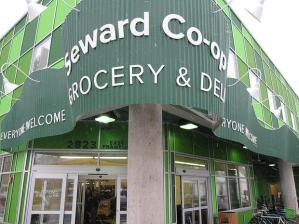 “Will the store cause a rise in rents?” one community resident asked during the July public meeting about Seward Community Co-op’s plan to open a store across from Sabathani Community Center. At the heart of the discussion were questions about race, class and food justice. How can Seward Co-op serve a community that is primarily African American and working class while it currently serves a community that is white and middle class? In other words, can a white-led co-op serve a black community?
“Will the store cause a rise in rents?” one community resident asked during the July public meeting about Seward Community Co-op’s plan to open a store across from Sabathani Community Center. At the heart of the discussion were questions about race, class and food justice. How can Seward Co-op serve a community that is primarily African American and working class while it currently serves a community that is white and middle class? In other words, can a white-led co-op serve a black community?
A few weeks prior to the community meeting, the Bryant community grapevine had gotten news that a local cooperative wanted to expand in the community. This led many in attendance to believe that the motives of those behind the co-op were not well intentioned. A group of Bryant community organizer/activists, At The Roots, began a campaign to engage community residents in the conversation.
FULL DISCLOSURE: LaDonna Redmond works for Seward Co-op as Education and Outreach Coordinator for the Friendship site in the Bryant neighborhood. This is one of a series of articles written as part of her Media Skills Fellowship with the TC Daily Planet:
Seward Co-op plans for second store run into questions of race, class and food justice
Friendship Co-op proposal: Opportunity for community or one more white space?
Seward Community Co-op’s partnership with the Carrot Initiative, a group of Central/Bryant residents who have been trying to recruit a store to locate in the local community, created some controversy. This partnership between the two entities seemed to add another layer of confusion to the proposed store. Other community groups suspected the Carrot Initiative members of having a hidden agenda to redevelop the community and push current residents out of the neighborhood.
More than 200 community residents braved the July heat to discuss the expansion of the Seward Community Co-op into the Bryant community. At the center of the firestorm was Seward Co-op, trying to explain the co-op model and the scope of the proposed project and to answer community concerns that ranged from gentrification to systemic racism.
Far from having the deal closed to build the co-op in the Bryant community, Seward leadership had to quickly figure out how to navigate the firestorm. Comments from community residents ranged from supportive to skeptical.
Seward Community Co-op is a 40-year-old co-operative that has expanded four times, along Franklin Avenue, within its operating history. Seward Community Co-op serves 11,000 households that live across the Twin Cities. Seward is ranked third in sales volume among co-ops nationally.
Currently, Seward Co-op is located on 28th and Franklin, in the Seward neighborhood of Minneapolis. The population of the Seward neighborhood in the 2010 U.S. Census was 7,308. The neighborhood population is 55 percent white and 33 percent black. The poverty level was 26 percent in 2005-2009.
Seward Co-op is proposing a to build a store in the Bryant community. Some 2,833 people live in Bryant, according to the 2010 U.S. Census. The African American population accounts for 33 percent of the residents. The white population is at 30 percent of the population. The neighborhood’s Latino population is at 28 percent. The poverty level in 2005-2009 was 40 percent.
Related: Community residents want to be heard, not ‘saved’ by new Seward Co-op in South Minneapolis (Alexa Horwart, 2013)
